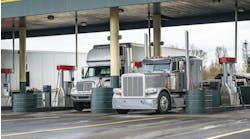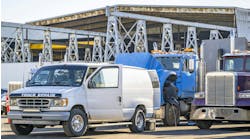A lot of attention is placed on safety scores. And rightly so.
Shippers look at them to make decisions on who they work with. Insurance companies use them as a metric on who they insure and what rates they charge. And lawyers look at them should litigation be on the table due to an accident.
Focusing on CSA Safety Measurement System scores isn’t a want-to; it’s a must. FMCSA has succeeded in making safety competitive, so fleets are trying to outdo each other for the sake of their scores. Effectively competing for better scores has implications on carrier selection by shippers, insurance rates, public perception—the list goes on. Moreover, carriers with weigh station bypass services benefit from better scores in terms of more bypasses, which translates to improved productivity. It’s perpetual in some respects.
But what can a carrier do to keep those scores as favorable as possible?
Look at the violation data from various areas. When a truck goes through different states, weigh stations, and inspection sites, drivers will notice that some locations focus on certain things more than others. For instance, one state might be hypersensitive to tire tread depth, and another might be closely watching for defective wiper blades. When it comes to what inspectors are looking for, all states aren’t created equal.
To illustrate, the American Transportation Research Institute did a study several years ago that showed marked differences between states in terms of the frequency with which they would cite certain violations.
For example, Connecticut was the top state in violations, with 52.2 citations per million vehicle miles traveled, more than double the national average of 22.8, according to the study. When you drill down further, the study also showed that Texas paid more attention to windshield wipers—if they were inoperable or defective. They were citing that at a rate of 12.2 per 100 vehicle inspections. The national average was only two per 100 inspections. That’s a marked difference. And though the report is now dated, recent evidence confirms that these disparities continue to exist.
Each violation has a “severity” rating or weight. A flat tire carries eight points, for example, while brake hose chafing is worth four. Then, those points are multiplied based on “time.” If the violation was in the last six months, the multiplier is three. At 12-24 months, the multiplier drops down to one. Stay tuned, however, since FMCSA has signaled its intent to fundamentally change these violation severity weights in early 2025.
See also: Drivewyze now providing virtual messaging to truck drivers in California, Michigan, and Nevada
To see your CSA data, visit the FMCSA Portal to register for access. This will show your fleet's safety scores and underlying violations contributing to those scores for each of the seven Behavior Analysis and Safety Improvement Categories:
- Crash indicator
- Hours-of-service compliance
- Vehicle maintenance
- Hazardous materials compliance
- Driver fitness
- Controlled substances/alcohol
- Unsafe driving
With that info, you can start analyzing the information to identify trends and areas for improvement. Here is how you can begin that journey:
- Track your scores over time: Monitor your scores regularly to see if they are improving or worsening, and look for the underlying causes. Is there a spike in particular violations, like violating lane restrictions, attributable to particular drivers?
- Identify problem areas: Focus on the BASICs with the highest scores, obviously, as these are areas where your fleet may be most at risk. But pay particular attention to the ones with the lower FMCSA intervention thresholds, like Unsafe Driving and Hours of Service.
- Identify locations of violations for identified problem areas: In most cases, fleets find specific states to be primary contributors to areas of concern. Further analysis can identify specific weigh stations or stretches of highway that are responsible for the majority of the violations identified within the state. A closer look will reveal enforcement emphases in these states (e.g., windshield wipers).
- Drill down into specific violations: Look at the specific violations that are contributing to your high scores. For example, most fleets with poor scores in the Unsafe Driving category will find they are attributable to speeding violations. But others may find they are attributable to something else, like lack of seat belt use.
- Compare yourself to industry averages: Use industry benchmarks to see how your fleet compares to others. After all, the scores are relative.
Once you have a handle on your violations, use that information to work with drivers, using these tips:
- Raise awareness: Be sure everyone who could impact the scores is aware of the importance and their respective roles in managing them. Provide regular updates company-wide on your improved performance.
- One-on-one meetings: Schedule individual meetings with drivers who disproportionately impact scores. The data will show you who they are.
- Enhanced training: Provide comprehensive training, not only on safety regulations generally but specifically on those areas attributable to elevated scores.
- Location-specific proactive driver alert on ELDs: One of the most impactful ways to communicate is by providing location-specific notifications to drivers, in the moment, to stave off violations. For instance, you could alert drivers as they are entering roadways where drivers are prone to lane restriction violations.
How smaller fleets can spot CSA trends
While large fleets can more easily spot trends in violations, smaller fleets often won’t have enough violations to do so. There is a way around that. Our Drivewyze Safety+ data, for example, gives fleets industry-wide trend data, revealing a significant variation of violations between states. For example, one state might be the top state for EOBR violations, while another might be the top state for lighting violations. Indiana is known for speed violations, but in addition, it is at the top of traffic violations in general, with more than six times the number issued compared to any neighboring state.
So, if some states have particular focus areas, how can a fleet be prepared to ensure drivers are ready so they don’t get a violation?
You need to communicate with drivers ahead of time where those violations are likely to occur. And that’s not easy unless you’re using technology. With Safety+, for example, we help fleets geo-fence violation hot spots. This way, their drivers will get an alert on their ELD and then be prepared for what's ahead.
Many of the fleets we work with geo-fence areas within Indiana, and other states reinforce that speed limits are strictly enforced. With in-cab alerts, fleets can see the impact of the notifications. One fleet saw a 50% reduction in speeding infractions within Indiana once the alerts were implemented. That’s significant.
Another fleet was getting most of their “failure to obey” infractions in a state where they only drove 5% of their miles. After it put in geo-fenced alerts around the problem areas, the fleet saw 92% of those infractions disappear.
Geo-fencing alerts can also be game-changers when weigh stations are known to focus on particular areas. Another fleet had its drivers pull over two exits ahead of an inspection site to double-check their tires because the site was known to focus on tread depth. The technology allows fleets to easily create geo-fenced zones and then track driver response. It’s totally customizable. Each fleet is different, with changing routes, so this tool lets fleets address pain points that are unique to them.
Ultimately, the goal is to help drivers and fleets be in compliance. The alerts are gentle reminders that can help drivers—and in turn help a fleet’s safety score—to the benefit of all.




